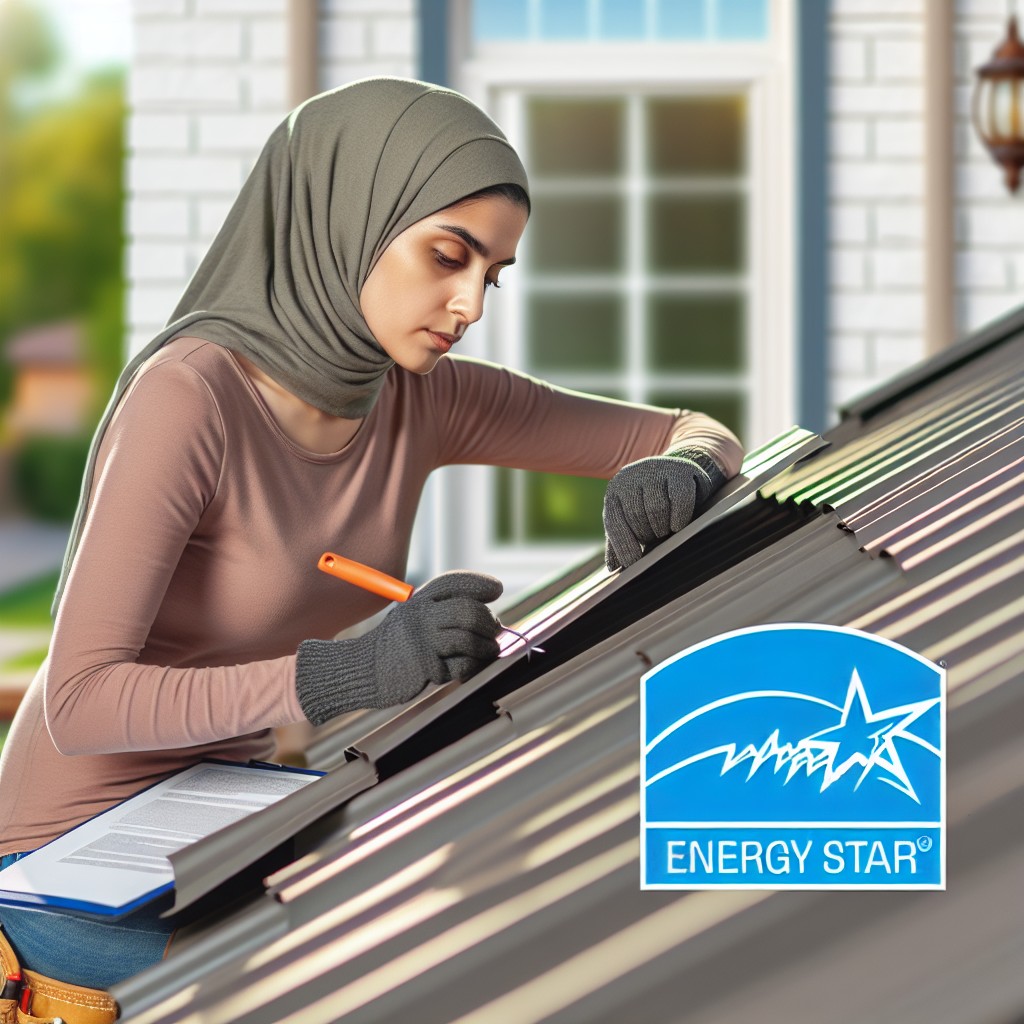Last updated on
Explore the lucrative benefits of metal roofs, because they don’t just provide shelter but may also yield significant tax credits.
Key takeaways:
- Metal roofs must be Energy Star certified
- Cool roofing with reflective pigments for energy savings
- Federal tax credit for the cost of installation
- Applicable to a homeowner’s primary residence
- Covers both material costs and installation expenses
Metal Roof Tax Credit Overview

The metal roof tax credit is a financial incentive provided by the federal government to encourage homeowners to invest in energy-efficient roofing. Here are the key points to understand this benefit:
- Energy Star Certification: To qualify, the metal roofing must be Energy Star certified, indicating it meets or exceeds energy efficiency guidelines.
- Cool Roofing Concept: Eligible metal roofs often incorporate reflective pigments to reduce heat absorption, known as ‘cool roofing’, which contributes to energy savings.
- Federal Tax Credit: A portion of the cost of the roof installation can be claimed as a nonrefundable tax credit, reducing the amount of income tax owed.
- Primary Residence: Typically applies to improvements made on a homeowner’s primary residence.
- Installation Requirements: The tax credit may cover both material costs and installation expenses.
It’s important to note that this overview provides the framework for understanding how the tax credit functions and its potential benefits. For specifics regarding current rates and eligibility, homeowners should refer to the latest tax code revisions.
Eligibility Requirements for Metal Roof Tax Credit

To qualify for a tax credit with a metal roof installation, ensure adherence to the following criteria:
1. Certification: The metal roof must be Energy Star certified, indicating it meets or exceeds energy efficiency guidelines set by the U.S. Environmental Protection Agency.
2. Principal Residence: The credit often applies to metal roofs installed on your main home, which must be located in the United States. It does not typically apply to rental properties or second homes.
3. Installation Period: The roof must be installed during the specified tax year for which you’re claiming the credit.
4. Compliance with Standards: The roofing material should meet defined standards for pigmented coatings or cooling granules designed to reduce heat gain.
5. Original Use: The tax credit is valid for new roofing material; reused or secondhand materials are ineligible.
6. Product Types: Both standing seam and metal shingles may qualify, but check specific product eligibility as not all metal roofing products will qualify.
7. Contractor Affidavit: Obtain an affidavit from the contractor certifying that the product is eligible for the tax credit. This serves as part of your necessary documentation.
Meet these criteria to benefit from potential tax savings when investing in a metal roof upgrade.
Types of Metal Roofs Qualifying for the Tax Credit
When considering a metal roof upgrade, it’s essential to know which materials qualify for the tax credit:
- Coated Metal Roofs: These must have pigmented coatings or cooling granules designed to reduce heat gain.
- ENERGY STAR Certified Roofs: Products bearing the ENERGY STAR label meet strict energy efficiency guidelines set by the EPA.
- Interlocking Metal Panels: Some tax incentives are available for interlocking panels that offer enhanced durability and longevity.
- Standing Seam Metal Roofs: This design features panels with raised seams that can improve weather resistance and may qualify for credits.
It’s important to verify that the specific product you choose complies with current energy-efficiency standards to ensure eligibility for the credit. Always consult the manufacturer’s certification statement for tax validation purposes.
Calculating the Metal Roof Tax Credit Amount
To determine how much you can save through the metal roof tax credit, consider the following points:
- Percentage-Based Credit: The credit usually amounts to a percentage of the cost of the metal roof, excluding installation costs. Check the latest tax guidelines for the current percentage.
- Cost Cap: There may be a cap on the total credit amount. Ensure you know the maximum allowable credit for roofing expenses.
- Energy Star Certification: Only Energy Star certified metal roofs are eligible. The credit may be higher for roofs that demonstrate greater energy efficiency.
- Proration for Roofing Portion: If the roofing project includes other renovations, only the cost attributable to the metal roofing qualifies for the tax credit.
- Inflation Adjustments: Credits may be subject to annual inflation adjustments. Verify if the current year’s credit has increased from the previous year.
Always reference the most recent IRS forms and publications for exact calculations, as tax laws and credits are subject to change.
Documentation Needed to Claim the Metal Roof Tax Credit
Obtaining the right documentation is essential when filing for a metal roof tax credit to ensure compliance and proper substantiation of the credit. Here are key documents to gather:
1. Manufacturer’s Certification Statement: This is a signed statement from the roofing material manufacturer certifying that the product qualifies for the tax credit. It’s important to keep a copy for your records.
2. IRS Form 5695: Use this form, titled ‘Residential Energy Credits,’ to report your expenses and calculate the credit.
3. Detailed Receipts: Preserve all itemized sales receipts and invoices that show the cost of the materials, excluding labor. These are critical for proving the investment made on qualifying roofing materials.
4. Proof of Payment: Retain copies of canceled checks, bank statements, or credit card statements as evidence of payment.
5. Date of Installation: Document when the installation was completed as the credit is only available for the year when the roof was placed in service.
Keep all documents organized and accessible when you file your tax return to validate your claim and avoid delays or complications with the IRS. Remember, only materials are covered by the credit, not installation costs.
Steps to Claim the Metal Roof Tax Credit On Tax Returns
To successfully claim the metal roof tax credit on your tax returns, follow these outlined steps:
- Confirm Your Eligibility: Ensure your metal roof meets all ENERGY STAR requirements, and review the IRS criteria for energy efficiency improvements.
- Keep Receipts and Records: Gather all purchase and installation receipts, including the Manufacturer’s Certification Statement, to authenticate your claim.
- Fill Out IRS Form 5695: Use this form to calculate the credit’s value based on your expenses. Enter your costs in the section titled “Residential Energy Efficient Property Credit.”
- Attach to Your Tax Return: Include the completed Form 5695 with your Form 1040 or 1040NR when filing your taxes.
- Enter Your Credit: Transfer the calculated credit amount to your tax return, typically on the line designated for “Residential Energy Credits.”
Consulting a tax professional or utilizing tax software can streamline the process, ensuring accurate results and maximizing your benefits.
Timeline and Expiration of the Metal Roof Tax Credit
The timeline for taking advantage of the metal roof tax credit is aligned with a specific tax year. Taxpayers should be mindful that the credit is not indefinite; it expires after a set period, often determined by government energy efficiency programs or legislation.
To ensure you don’t miss out, check the latest provisions in the federal tax code. Credits can be extended or modified, and understanding current law is critical.
Tax credits may have retroactive application to previous tax years. Consult a tax professional to ascertain if a recently expired credit could still be of benefit.
Keep abreast of congressional sessions as expiring tax incentives, including those for metal roofs, may be renewed or replaced with new legislation.
Lastly, be proactive in planning roofing improvements around such credits, leveraging the financial incentives before their scheduled sunset.
Impact of Metal Roof Tax Credit On Roofing Decisions
The availability of a tax credit for installing a metal roof can significantly influence homeowners’ renovation choices. Several considerations come into play, including:
- Long-term Savings: The immediate benefit of a tax credit, combined with the durability and energy efficiency of metal roofing, can offset higher upfront costs.
- Property Value: A metal roof can enhance a home’s resale value, with the tax credit serving as an added incentive.
- Environmental Impact: For those prioritizing sustainability, the tax credit serves as an encouragement to choose environmentally friendly roofing materials.
- Energy Efficiency: Metal roofs reflect solar radiant heat, which can reduce cooling costs and increase appeal for homeowners in warmer climates.
- Insurance Premiums: Some insurers offer discounts for metal roofs due to their resistance to fire, hail, and wind, making the tax credit a starting point for ongoing savings.
These factors emphasize the financial advantages and broader benefits of choosing a metal roof, making the tax credit not only an immediate perk but also a catalyst for smarter, value-oriented home improvements.
Tax Credits Vs. Deductions for Metal Roofs
Understanding the difference between tax credits and deductions is essential when installing a metal roof. Tax credits directly reduce your tax liability dollar for dollar. In contrast, tax deductions lower your taxable income, which indirectly reduces your tax burden based on your income tax bracket.
Here are key points to keep in mind:
- A tax credit is more beneficial than a deduction of the same amount because it reduces the tax you owe on a one-to-one basis.
- If you receive a $1,000 tax credit, your tax bill decreases by $1,000. However, a $1,000 deduction only drops your taxable income, leading to a tax saving that depends on your marginal tax rate.
- Tax credits for metal roofs are often available for energy-efficient home improvements, recognizing the sustainability benefits of choosing such materials.
- Make sure to consult with a tax professional to understand the current tax incentives for metal roofs and how they may apply to your specific financial situation.
FAQ
Can you write off a new metal roof?
Yes, homeowners can write off a portion of the cost of a new energy-efficient metal roof, up to a maximum credit limit established by the IRS.
What qualifies for energy tax credit in 2023 IRS?
For the tax year 2023, the IRS offers a 30% clean energy tax credit for investments in renewable home energy solutions such as solar, wind, geothermal, fuel cells, and battery storage technology.
Can you deduct a new roof on federal taxes?
No, a new roof cannot be deducted on federal taxes.
What is the tax credit for Energy Star shingles in 2023?
In 2023, Energy Star shingles qualify for a 30% tax credit on expenses up to $5000, offering homeowners up to $1500 in savings.
How does the ‘Residential Energy Efficient Property Credit’ apply to metal roofs in 2023?
In 2023, the ‘Residential Energy Efficient Property Credit’ applies to metal roofs by offering homeowners a 26% tax credit on the total cost of qualifying energy-efficient roofing materials and installation.
What is the specific criteria for a metal roof to qualify for a tax deduction according to the IRS 2023 guidelines?
According to the IRS 2023 guidelines, a metal roof qualifies for a tax deduction if it has a Solar Reflectance Index (SRI) of 25 or higher and meets Energy Star program requirements.
In 2023, what is the amount of tax credit available for energy-efficient roofing materials other than Energy Star shingles?
As of 2023, the tax credit available for energy-efficient roofing materials other than Energy Star shingles is 26% of the cost.





